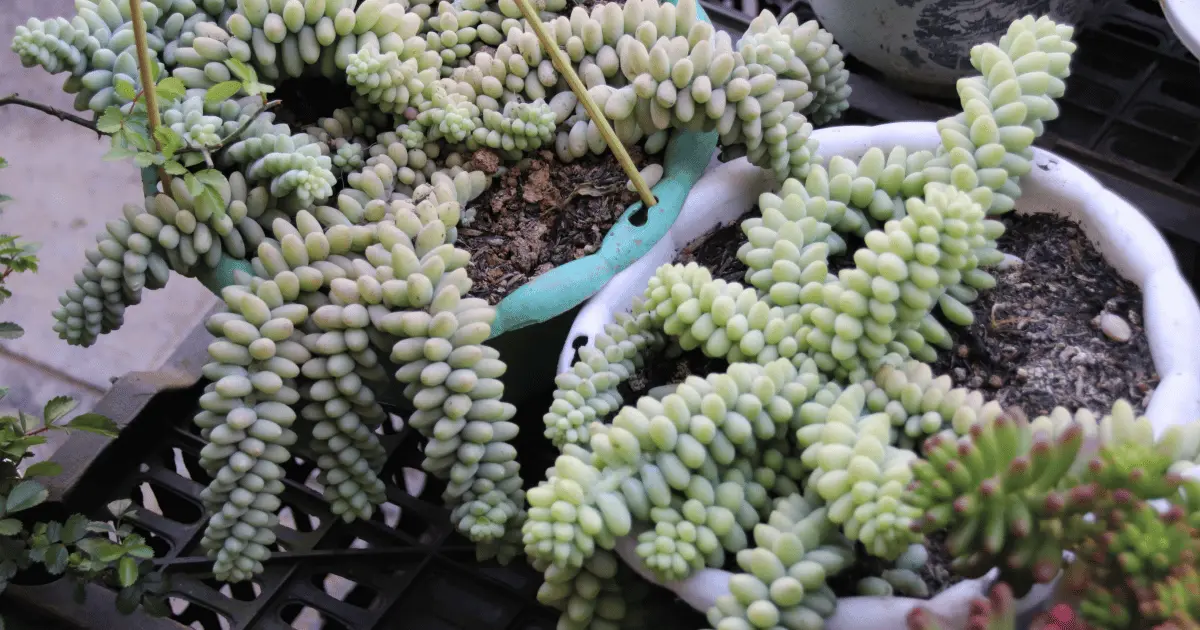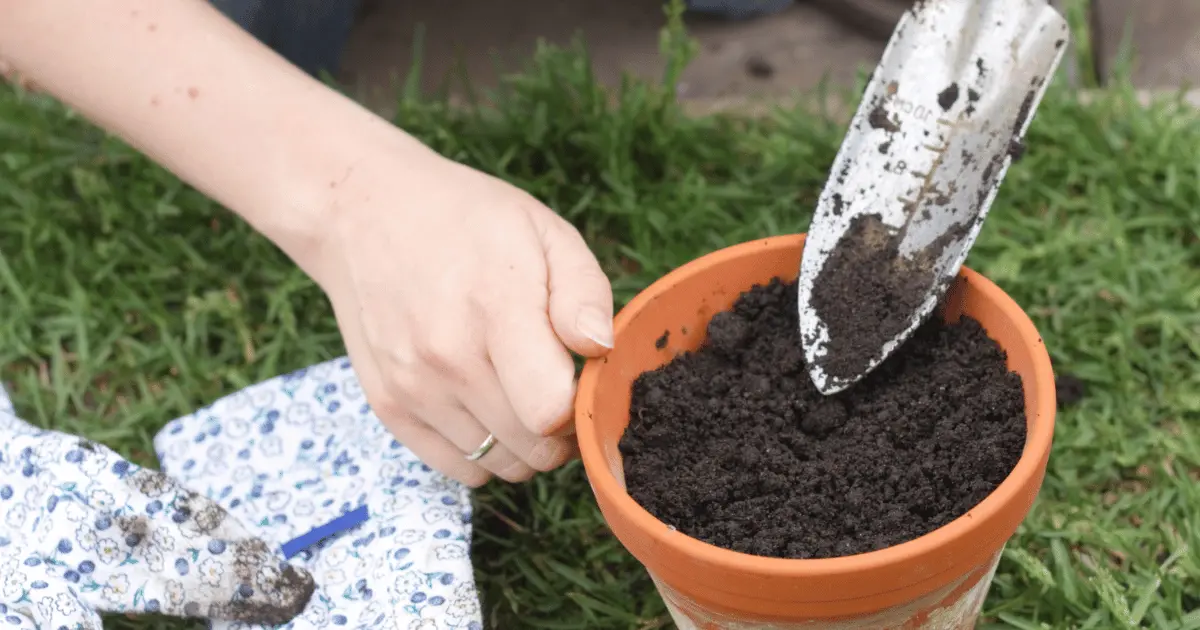Burro’s Tail, Sedum morganianum, is a luscious evergreen fleshy flowering garden plant propagated mostly as an indoor or outdoor ornamental garden shrub. It’s an excellent houseplant mostly distinguishable by its intersecting elongated crawling shoots and pinpointed globular beryl-colored foliage, which mostly terminates in proximal blooms of varying shades, from pink to red.
Also popularly called Donkey’s Tail, the Burro’s Tail Plant has a history of being first domesticated from the Deciduous Tropical Forests of East Mexico. They’re mostly summer bloomers and can easily be propagated; growing new pots doesn’t take too long, and neither do you need to be skillful in gardening to do it.
Propagating Burro’s Tail

Growing Burro’s Tail plants around you adds a touch of mystery and wild beauty to the aesthetics of your home and office areas, and their low maintenance requirements make them the ideal decorative plants to grow.
You’ll know they’re ready for propagation when their leggy stems start to puck out through the drain holes of the baskets, making them look like giant crabs. Burro’s Tail pots are so wonderful and ready to survive that even their leaf cuttings can be grown into new plants. Let’s discuss how to grow them from leaf and stem cuttings.
Preparing your Burro’s Tail Cuttings
Leaf cuttings can be chosen from a well-grown stem. Select the leaves that aren’t injured in any way, and have an even-green appearance. Cut off the leaves from the nodes and ensure the leaf stalk is still attached to each one of them.
Take as many leaf cuttings as possible because only about 80% have a good chance of rooting successfully. Once the cuttings have healed after a few hours, they can be rooted in a potting mix. But first, let’s also make some stem cuttings to root simultaneously.
I usually make my cuttings in Spring, just as the plant gains some vigor after sleeping through winter. To improve our chances of success, we only select the younger leggy cuttings with axial growths at their apex tips and fully grown leaves with their leaf nodes.
Cut off the stems right below their nodes using any cutting tool. Each cutting should be 4-6 inches long and have 2-3 leaves growing on it.
Now we remove the residual leaves at the sides of the cuttings and allow them to heal for 2-3 days before rooting them.
I’m not particularly eager to root leaf cuttings in water because it takes forever to grow; rooting them in a potting soil mix is a better chance of success. The stem cuttings can be rooted in water or a potting mix, and we’ll discuss how shortly.
Rooting your Donkey Tail Cuttings in Water
A jar of water is all you need, and some patience. Pour clean water into a glass jar or gardening vase and place your cuttings in it; up to three cuttings can be rooted together in a single jar.
When done, place it beside the window sill and change the water regularly. Your cuttings will begin to root after 2-3 weeks, and you should transplant them in a potting medium once the roots grow 1 inch long.
Rooting your cuttings in a Potting Medium

Pour some potting soil mix earlier prepared into a clay or plastic pot meant for the rooting and drill several holes at the surface for the cuttings. If you’re rooting leaf cuttings, gently place those that still have their stalks on the pot’s soil mix surface.
Insert your stem cuttings in the holes and add more potting soil for better grip; next, water the pot with the cuttings immediately, allowing the excess water to run off visibly.
Place the pot on a well-illuminated surface and keep it moist for 3-4 weeks. When your cuttings grow to an inch in length, you may continue growing them in the same pot or repot them separately.
Best Sunshine and Humidity Conditions to Propagate Burro’s Tail
Their pots should always be positioned at a spot that receives more than 6 hours of bright indirect sunshine daily; the available sunlight intensity will determine their level of Vigor and total health. You can bring them out during their flowering seasons to receive one or two hours of direct sunshine daily.
When they’re not receiving sufficient bright light, they stop growing new internodes, and the plant begins to look discolored and scanty. Sunning them excessively is also a factor to watch out for; the tips of their leaves will gradually become dull and yellowish as they suffer sunburns.
To keep them healthy, they should stay within the brightness of direct sunshine before they’re taken indoors, where the light is diffused. They can be placed around the verandah, on a kitchen cabinet, dining or center table, or beside a Southward or North-facing window.
The bedroom is also a great place to pot them, but try as much as possible to keep them away from bathrooms, air vents, or behind the refrigerator; these places are known to have extreme heat and water saturation, so they’re not helpful to Burro’s Tail plants.
Watering your Burro’s Tail Pots
It’s very easy to over-water your Donkey Tails, which presents a major setback to their development. They generally don’t like to be kept in a moist potting as that could make their roots rot. When they seem over-watered, some signs to look out for include yellowing of the leaves, which eventually begin to wither and fall off.
Burro’s Tail plants demonstrate some levels of drought tolerance, but only for a short time; they will only grow to their fullest potential when they’re receiving enough water frequently. It would be best if you watered them once every 7-10 days when they’re still growing actively or whenever their potting soil mix looks dry on the surface.
Because of their trailing nature, misting or using air humidifiers is a great option for them if you’re always certain the excess water will completely dry off very quickly. When left in a damp or moist situation for some time, the leaves might develop fungal infections and eventually begin to rot.
You may water them using bottle sprays or give them light showers frequently to keep them hydrated. Bottom watering is also a great option to moisturize them from the roots. They typically require much less watering as winter approaches, and you only give them light showers once or twice in three weeks.
Preparing the Right Potting Mix for Burro’s Tail

They always prefer being potted in a fast-draining sandy soil potting. Being the typical tropical succulent vining garden plants, a soggy and slushy potting soil that traps water for too long might cause their leaves to rot.
Your Donkey Tails are more specific about their potting requirements; if the potting mix is enriched with some compost, Peat moss, and perlite, it’ll work perfectly for them.
I sometimes create my lightweight homemade potting mix by combining one part perlite or vermiculite for a more gritty soil mix, one part Peat moss to improve the aeration, with two parts cactus potting mix or succulents soil mix.
They need a soil mix that doesn’t hold water for too long, has the right airflow, and enough pores for the roots to burrow into. Making tiny holes around the sides and bottom of the potty also greatly improves its aeration and drainage.
They’re ubiquitous and won’t mind having space to crawl out of their pots; a hanging basket does a lot of good in displaying their gorgeous blooms as they pour lavishly from the sides, cascading down their 60cm long shoots on all sides.
I always enjoy propagating my Burro’s Tail plants just for the pleasure of relishing the sight of their 2-foot long, massively crammed knob-like green foliage, which mostly overlap one another. They are such lovely darlings with striking appearances that easily become the point of conversations with visiting friends.
Mainly propagated as indoor and outdoor decorative plants, they can also be grown as a perfect ground covering during winter combined with similar deeply pigmented flowering plants.
A few of their varieties are edible and safe for consumption. However, most of them will cause degrees of digestive disturbances due to the presence of alkaloids in their various parts.
Burro’s Tail pots hardly have any toxic effects on humans and animal pets; they’re absolutely friendly and biologically safe to have around; if you’re wondering why the name ‘Burro’s Trail,’ wait until you grow them to maturity and their stems begin to travel out of their pots, they look much like the tail of a burrowing animal.
